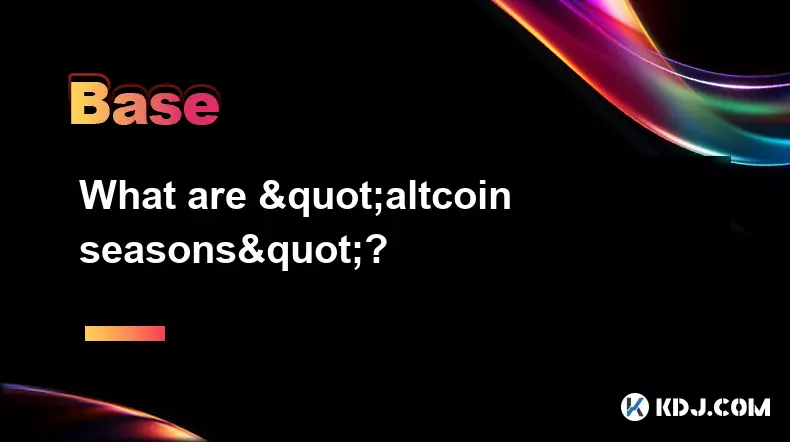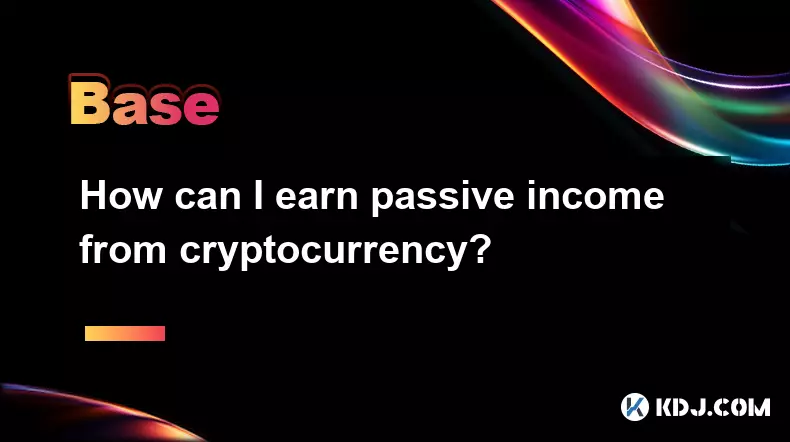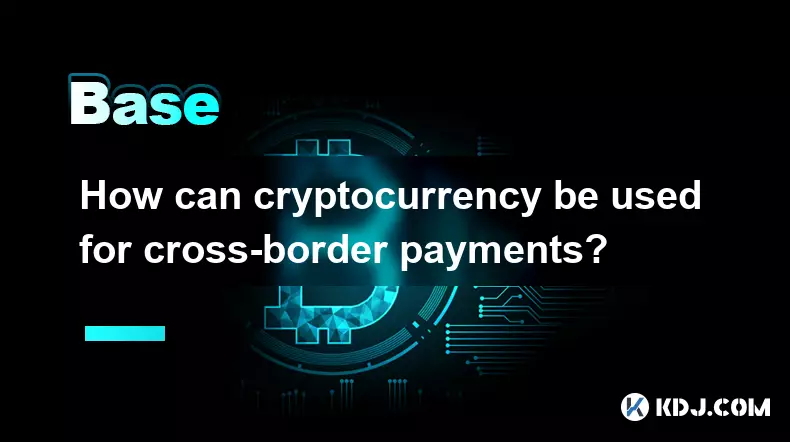-
 bitcoin
bitcoin $109523.663807 USD
-0.13% -
 ethereum
ethereum $4019.526508 USD
2.06% -
 tether
tether $1.000482 USD
0.00% -
 xrp
xrp $2.776815 USD
0.18% -
 bnb
bnb $958.942396 USD
0.12% -
 solana
solana $204.294698 USD
3.84% -
 usd-coin
usd-coin $0.999693 USD
0.00% -
 dogecoin
dogecoin $0.232115 USD
2.09% -
 tron
tron $0.338028 USD
0.84% -
 cardano
cardano $0.790920 USD
1.50% -
 hyperliquid
hyperliquid $44.871443 USD
5.60% -
 ethena-usde
ethena-usde $1.000322 USD
0.04% -
 chainlink
chainlink $21.034165 USD
2.60% -
 avalanche
avalanche $28.794831 USD
-0.54% -
 stellar
stellar $0.360466 USD
1.24%
What are "altcoin seasons"?
An altcoin season occurs when altcoins surge in value relative to Bitcoin, driven by shifting capital, market sentiment, and narratives like DeFi or AI blockchains.
Sep 15, 2025 at 03:36 am

What Defines an Altcoin Season?
1. An altcoin season refers to a period in the cryptocurrency market when alternative cryptocurrencies, or altcoins, experience significant price growth compared to Bitcoin. During this time, capital flows out of Bitcoin and into various altcoins, leading to widespread gains across the broader crypto market.
2. This phenomenon is often measured by the ratio of the total market capitalization of altcoins to that of Bitcoin. When this ratio increases substantially, analysts consider it a strong indicator of an ongoing altcoin season.
3. Altcoin seasons typically occur after a prolonged Bitcoin bull run, once Bitcoin’s price has stabilized or slowed its ascent. Investors then seek higher returns in riskier assets, turning their attention to promising altcoins with strong fundamentals or emerging narratives.
4. Market sentiment, technological developments, and macroeconomic conditions play crucial roles in triggering such periods. Positive news around decentralized finance (DeFi), non-fungible tokens (NFTs), or layer-1 blockchain innovations can act as catalysts for altcoin momentum.
5. Social media trends, influencer endorsements, and coordinated retail investor movements also contribute to the rapid rise of certain altcoins during these phases, amplifying volatility and speculative activity.
Key Drivers Behind Altcoin Momentum
1. Technological upgrades on major blockchain platforms often precede altcoin rallies. For example, Ethereum’s transition to proof-of-stake or network scalability improvements can reignite investor confidence and drive capital into ecosystem-related tokens.
2. New project launches through initial decentralized offerings (IDOs) or yield farming incentives attract liquidity from yield-seeking traders. These mechanisms create early excitement and speculative demand.
3. Increased institutional interest in specific sectors like Web3, metaverse infrastructure, or real-world asset tokenization can lead to targeted investments in related altcoins, creating sector-wide momentum.
4. Exchange listings on major platforms such as Binance, Coinbase, or Kraken provide visibility and trading access, often resulting in immediate price spikes due to heightened demand and reduced supply availability.
5. Broader market liquidity conditions, including loose monetary policy or stablecoin inflows into exchanges, enhance risk appetite and enable larger positions in altcoins with lower market caps.
Recognizing the Signs of an Altcoin Season
1. A noticeable shift in trading volume toward altcoins, especially on global exchanges, signals growing participation. Volume spikes in tokens like Solana, Cardano, or Polkadot often precede broader market movement.
2. Bitcoin’s dominance metric—its share of the total crypto market cap—begins to decline. Sustained drops below key thresholds, such as 40% or 35%, are historically associated with active altcoin cycles.
3. Emergence of viral narratives around specific projects or technologies, such as AI-integrated blockchains or privacy-focused coins, captures retail attention and fuels FOMO-driven buying.
4. DeFi protocols report surging total value locked (TVL), indicating renewed trust and capital deployment into decentralized applications built on altcoin-powered chains.
5. Exchange reserve data shows decreasing Bitcoin holdings and increasing altcoin deposits, suggesting traders are reallocating assets in anticipation of outsized returns.
Frequently Asked Questions
What causes altcoin seasons to end?Altcoin seasons often conclude when market sentiment turns risk-averse, typically triggered by regulatory crackdowns, security breaches in major protocols, or a resurgence in Bitcoin’s price dominance. Profit-taking after sharp rallies also leads to capital rotation back into Bitcoin or stablecoins.
Can stablecoins influence altcoin performance?Yes. Inflows of stablecoins like USDT or USDC into exchanges often precede altcoin buying pressure. Traders use stablecoins to enter positions without exposing themselves to Bitcoin’s volatility, making them a leading indicator of potential altcoin rallies.
How do exchange fees affect altcoin trading behavior?Lower trading fees on altcoin pairs encourage higher-frequency trading and arbitrage opportunities. Exchanges sometimes reduce fees during promotional events, which can temporarily boost trading volume and liquidity for less popular tokens.
Are memecoins part of altcoin seasons?Memecoins frequently gain disproportionate attention during altcoin seasons due to their low entry price and social media virality. While they lack fundamental utility, coins like Dogecoin or Shiba Inu have historically contributed to the speculative frenzy characteristic of these periods.
Disclaimer:info@kdj.com
The information provided is not trading advice. kdj.com does not assume any responsibility for any investments made based on the information provided in this article. Cryptocurrencies are highly volatile and it is highly recommended that you invest with caution after thorough research!
If you believe that the content used on this website infringes your copyright, please contact us immediately (info@kdj.com) and we will delete it promptly.
- Bitwise, Solana, and the ETF Filing Frenzy: What's the Deal?
- 2025-09-28 06:25:16
- Ruvi AI: Surpassing Tron's Demand, the Next 100x Token?
- 2025-09-28 06:25:16
- BSE, IPOs, and Crypto Funds: A New York Minute on India's Regulatory Tightrope
- 2025-09-28 06:30:01
- Ruvi AI: The Avalanche Ecosystem's Next Big Thing, Blazing Through Phase 3
- 2025-09-28 06:30:01
- Tron, Ruvi AI, and Institutional Backing: What's the Buzz?
- 2025-09-28 06:30:01
- Q-UP: Is Coin Flipping the Next eSports Sensation? A Look at Fairness in Gaming
- 2025-09-28 06:30:15
Related knowledge

What are some common methods of cryptocurrency market manipulation?
Sep 27,2025 at 02:55am
Wash Trading and Its Impact on Market Perception1. Wash trading involves an individual or entity simultaneously buying and selling the same cryptocurr...

How do I read a cryptocurrency whitepaper?
Sep 27,2025 at 05:54am
Understanding the Structure of a Cryptocurrency Whitepaper1. Begin by identifying the executive summary, which outlines the project’s core vision and ...

Can I recover lost cryptocurrency?
Sep 25,2025 at 08:18am
Understanding the Nature of Cryptocurrency Loss1. Cryptocurrency operates on decentralized networks, meaning there is no central authority to reverse ...

How do I choose a cryptocurrency investment strategy?
Sep 27,2025 at 03:55pm
Understanding Risk Tolerance in Crypto Investing1. Assessing personal risk tolerance is a foundational step when entering the cryptocurrency market. V...

How can I earn passive income from cryptocurrency?
Sep 23,2025 at 10:18am
Staking Cryptocurrencies for Regular Returns1. Many blockchain networks operate on a proof-of-stake (PoS) consensus mechanism, allowing users to earn ...

How can cryptocurrency be used for cross-border payments?
Sep 28,2025 at 01:36am
Efficiency in International Transactions1. Cryptocurrency enables near-instant settlement across borders without relying on traditional banking interm...

What are some common methods of cryptocurrency market manipulation?
Sep 27,2025 at 02:55am
Wash Trading and Its Impact on Market Perception1. Wash trading involves an individual or entity simultaneously buying and selling the same cryptocurr...

How do I read a cryptocurrency whitepaper?
Sep 27,2025 at 05:54am
Understanding the Structure of a Cryptocurrency Whitepaper1. Begin by identifying the executive summary, which outlines the project’s core vision and ...

Can I recover lost cryptocurrency?
Sep 25,2025 at 08:18am
Understanding the Nature of Cryptocurrency Loss1. Cryptocurrency operates on decentralized networks, meaning there is no central authority to reverse ...

How do I choose a cryptocurrency investment strategy?
Sep 27,2025 at 03:55pm
Understanding Risk Tolerance in Crypto Investing1. Assessing personal risk tolerance is a foundational step when entering the cryptocurrency market. V...

How can I earn passive income from cryptocurrency?
Sep 23,2025 at 10:18am
Staking Cryptocurrencies for Regular Returns1. Many blockchain networks operate on a proof-of-stake (PoS) consensus mechanism, allowing users to earn ...

How can cryptocurrency be used for cross-border payments?
Sep 28,2025 at 01:36am
Efficiency in International Transactions1. Cryptocurrency enables near-instant settlement across borders without relying on traditional banking interm...
See all articles










































































